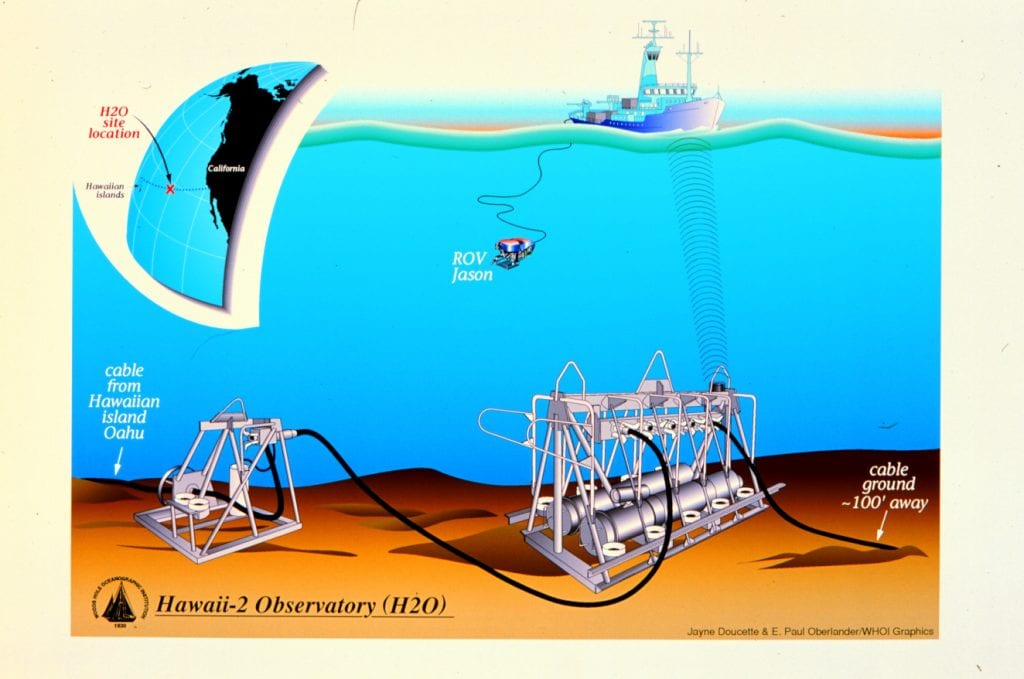Scientists Plug Into Power and Communications ‘Outlet’ on the Seafloor
September 24, 1998
Scientists and engineers from the Woods Hole Oceanographic Institution (WHOI) and colleagues have successfully created the first permanent deep ocean seafloor observatory in the United States by connecting a junction box to a retired telephone cable on the seafloor in the middle of the Pacific Ocean between Hawaii and California. The observatory rests in 5.0 kilometers (16,400 feet) of water almost halfway between Hawaii and California, along a relatively featureless part of the seafloor between the Murray and Molokai Fracture zones. It was installed late last week during a nearly month-long cruise.
“It was a risky operation, but something we have wanted to do for a very long time,” notes Dr. Alan Chave, a Senior Scientist in the Institution’s Geology and Geophysics Department and the Chief Scientist on the cruise. “Up to now we have been limited by technology and logistics to support a permanent undersea geophysical observatory. Now we have the technology with WHOI’s remotely operated vehicle (ROV) Jason, the titanium junction box, and the cable providing the power and communications source, to link us back to shore. The two-way digital signals carried by the cable are unique in that they allow us to ‘talk’ to our instruments on the seafloor so that we can program and troubleshoot them from land.”
Named the Hawaii-2 Observatory, or H2O, the project was coordinated through the Incorporated Research Institutions for Seismology (IRIS) under the direction of Dr. Rhett Butler, global seismic network program manager. The project is funded by the National Science Foundation at a cost of approximately $3 million dollars. In addition, Dr. Fred Duennebier’s group at the University of Hawaii designed the power supply and built a broadband seismic package that attaches to the junction box designed and built at WHOI. A broadband seismometer and a standard hydrophone were the first instruments installed at the site. Now that the power is flowing through the cable the instruments are listening for seismic events such as earthquakes and tsunamis.
Dr. Alan Chave and WHOI engineers designed and built the unique ‘junction box’ and cable termination of titanium. They installed them by splicing into the middle of the submarine telephone cable connected to AT&T’s Makaha cable station on the island of Oahu. Once the cable was cut they lifted the cut end of the cable and brought it on to the ship, then attached the cable to the termination. The junction box, which consists of communications electronics, a power supply, and eight connecting ports into which instruments can be plugged, was attached to the termination. Once the instruments were tested on deck and their connections were secure, the junction box and the termination were deployed, using the ROV Jason, to the ocean floor. Three hundred watts of electricity is now powering the instruments, and two-way digital signals are being sent via the internet, enabling data from the instruments to be shared by scientists in real-time.
In the future, scientists from universities and research laboratories around the world will be able to plug their particular instrument into the H2O junction box (with the help of a human occupied submersible like WHOI’s three-person Alvin or with an ROV like Jason), then unplug the instrument when their experiment is complete.
“Recent technological advances and the retirement of certain coaxial seafloor telecommunications cables has enabled the establishment of seafloor observatories like H2O that are connected to shore by a dedicated cable,” says H. Lawrence Clark, Director of the Oceanographic Technology and Interdisciplinary Coordination Program at the National Science Foundation. “The ability to continuously receive and record oceanographic data and communicate with scientific instruments on the seafloor promises to advance ocean science knowledge and predictive capabilities.”
##

